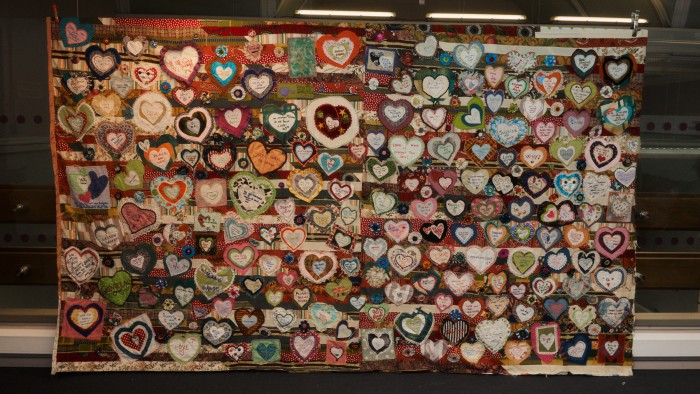Unlock the Editor’s Digest for free
Roula Khalaf, Editor of the FT, selects her favourite stories in this weekly newsletter.
Tuesday Greenidge is a regular at North Kensington Library, where you’ll often find her sewing at its large communal desk. When we meet in February, she is wearing a khaki raincoat made, not coincidentally, from Grenfell cloth. Greenidge, a textile artist, has lived in this west London neighbourhood for more than 30 years. For the past eight, she has been working on her greatest masterpiece, a 220ft by 72ft hanging art piece: the Grenfell Memorial Quilt.
“We wanted to commemorate the people we knew,” says Greenidge. Her daughter, Charlie, was one of the survivors the night of 14 June 2017 when Grenfell Tower, a 24-storey social-housing block in the centre of the community, set alight. The fire took 72 lives, sparking one of the biggest human-rights crises in recent British history. Subsequent research has discovered that 70 per cent of the UK’s social housing towers have fire safety issues such as flammable cladding, ineffective fire doors or broken emergency lighting.
After seeing the offerings of flowers, teddies and hearts – the green heart in particular has become synonymous with the Grenfell community – left as tributes on the neighbouring streets following the disaster, Greenidge was inspired to immortalise the tragedy in a quilt. “There were clothes just dumped in the area,” she says. “When we were sorting them, we were crying. They were rags. We’re making something beautiful.”
Drawing reference from the Aids Memorial Quilt pioneered by US activist Cleve Jones as a memorial for those who had died of the disease (to which Greenidge contributed while visiting the London Lighthouse clinic located next to Grenfell in the 1990s), Greenidge wanted to create an artwork in the dimensions of the tower block that could be easily separated for individual commemorations. Pieces of the quilt have since been exhibited at the Notting Hill Methodist Church, Alexandra Palace and Birmingham’s Festival of Quilts. Greenidge began researching the American jelly-roll technique, where bundles of pre-cut fabric strips are stitched together. She describes the process as “#Rags-to-ritsch-kitsch-bitsch”, with most of the original fabric sourced from sheets and old shirts.

The first panel – a 12ft by 12ft piece with a patch dedicated to Raymond “Moses” Bernard, who died alongside six other victims in his top-floor flat – was completed in 2018. Greenidge’s once “nomadic group” of sewers has since become a unit of 15 to 20 people who meet at the library every week. Anyone is welcome, from fashion students to members of Whitstable’s Profanity Embroidery Group, whose tapestries promote the “stress-relieving” properties of swearing. Crochet hearts and flowers from crafting communities in Brazil and Mumbai have also been received.
More recently, Greenidge has teamed up with the Quilters’ Guild, establishing a network of sewing bees in libraries around the country to help finish the quilt in time for Grenfell’s 10th anniversary in 2027, and also to ensure that community crafts continue beyond its completion. Colourful and eclectic, the quilt has grown to 220ft by 12ft – 50ft in width off Greenidge’s target. One tapestry records the names of the 72 victims; a panel – “Forget Me Not” – recalls the grid-like structure of the building in a tie-dye mirage. Greenidge points to another small patch emblazoned with the northern star “to set spirits free” and a boxing-themed eulogy for Tony Disson, who was a trainer at a small boxing club on Grenfell’s lower floors. They have lost count of the number of hearts. The goal is to hang the finished quilt in a prominent location and to photograph each heart for an upcoming book.

Greenidge’s earliest collaborator was Alexandra Brown, a Savile Row tailor who taught her how to sew. The pair met in 2012 at 240Project, a local health centre for those affected by homelessness and exclusion where Brown was volunteering and is now a wellbeing officer. “The healing that has taken place through the making of the quilt is something that cannot be put into words,” she says. “Tuesday has brought the community together at a time of great sadness, transmuting grief and creating the most beautiful tribute.” Further support has come from BBC radio presenter Eddie Nestor, whose call for volunteers and fabric donations in 2022 launched Sewing for Justice, a collective of “craftivists” – where crafting meets activism – “artivists” and “sewists” contributing to the quilt.
“What I always liked about the quilt was that, in a space which is very noisy, very chaotic and has become quite performative, it was this quiet thing going on in the background, providing people with a moment of peace,” says Kimia Zabihyan of Grenfell Next of Kin, a group representing the bereaved families. Later this month the group will present an installation at the Milan Triennial’s Cities exhibition, where the quilt will be displayed in front of its largest audience yet.

“It’s going to be global,” says Greenidge, who points to flammable cladding – found to be the “principal cause for rapid fire spread” at Grenfell – as a worldwide issue. Of the 4,613 buildings above 11m in the UK that have been identified as having non-compliant cladding, only 1,350 have completed remediation. The crisis stretches to India, China and Australia, where a 23-storey apartment block was obliterated by a cladding fire three years before Grenfell.
The exhibition in Milan follows the UK government’s recent announcement that Grenfell’s structure will be demolished, a process expected to take two years. “I’m not one of the bereaved, I’m not one of the survivors,” says Greenidge. “But it’s not safe. It’s falling down. Let’s turn it into a wonderful space where we can all unite.” The quilt, she says, “is part of a legacy project. We’d like to encourage it to continue as a way for people to understand social justice – and social justice starts at home.”
Cities is at Triennale Milano from 13 May to 9 November, triennale.org/en/events/cities




